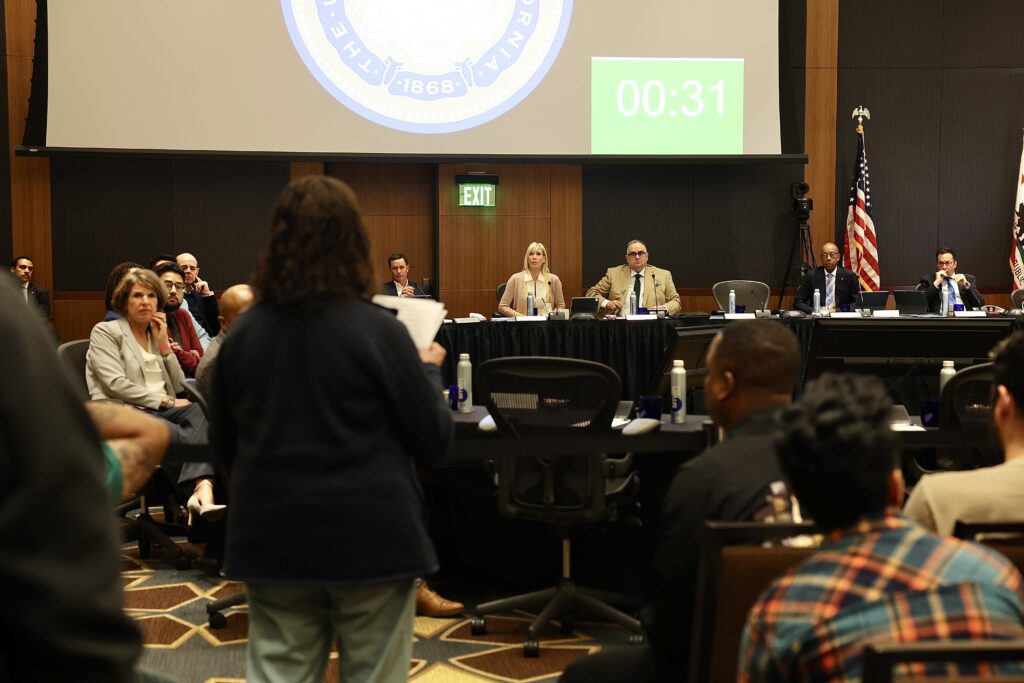
Children pose on the steps of Immigrants Development Center of San Francisco in the 1970s.
Credit: San Francisco History Center, San Francisco Public Library
Fifty years ago, the U.S. Supreme Court decided a case that would forever change education for English learners in this country.
In the 1974 case Lau v. Nichols, the court decided that students learning English had a right to fully understand what was being taught in their classrooms, and that schools must take steps to make sure that they could, whether through additional instruction in English as a second language or bilingual education.
Prior to the Supreme Court’s decision, the 9th U.S. Circuit Court of Appeals had said that San Francisco Unified was not discriminating against students by giving them the same materials and instruction as other students.
Rather, it said the alleged discrimination was “the result of deficiencies created by the children themselves in failing to learn the English language.”

The Supreme Court disagreed. “There is no equality of treatment merely by providing students with the same facilities, textbooks, teachers, and curriculum; for students who do not understand English are effectively foreclosed from any meaningful education,” wrote Justice William O. Douglas in the majority opinion.
The Lau v. Nichols case is named for one of the plaintiffs, a little boy named Kinney Lau, who had recently emigrated from Hong Kong. Kinney Lau’s first grade teacher at Jean Parker Elementary School in San Francisco was Lucinda Lee Katz.
In an interview, Katz shared how this case marked her life, how it changed education for English learners and what remains to be done to give English learners full access to the same instruction as their peers.
This interview was edited for clarity and brevity.
How and why did you get involved with the Lau v. Nichols case?
When I became a teacher, I had Kinney Lau in my first grade classroom. And Mrs. Lau said to me, “Miss Lee, I come from Hong Kong where all the students are exposed to two languages. We can read, write, speak and learn in English and Cantonese. I don’t understand why we can’t do that in San Francisco. Can you help us? Because Kinney is losing his experience with math learning, and I want him to keep up.”
English was the first language of instruction. Sometimes I could interpret or translate, but I knew I was stepping out of my lane when I did that.
Mrs. Lau wanted formal instruction. She said, “I get it if you have to teach English and writing in English, but he’s losing valuable time not understanding math. So could you just teach math in Chinese?
So that was the first conversation. I went home and told my roommates. They were all in law school. And I said, “Can we do something about it?” They took it to (the San Francisco) Neighborhood Legal Assistance (Foundation), and the person who took it on was Ed Steinman. And he took it all the way to the Supreme Court.
What was your own experience in school like as a child, and how did it influence you?
I went through Washington Irving Elementary School, Francisco Middle School and Lowell High School. I had not one Chinese teacher.
My kindergarten teacher, Mrs. Thompson, kept saying, “No Chinese! No Chinese here! No Chinese!” All the kids in the classroom were Chinese and Chinese-speaking. As a kindergartner, I noted that, and I said to myself, “What is she talking about? She’s the only one that can’t speak Chinese, and I don’t get this.” So it stayed in my mind for a very long time.
My father and his father were from China. And in 1882, the Chinese Exclusion Act was the first significant law that was passed by Congress restricting Chinese immigrants. It’s actually one of the most discriminatory laws in the books. Interestingly, the 1906 earthquake fire destroyed all the records in San Francisco. And as a result of that, and because of the discrimination, the Chinese found a way to come over through the “paper sons and daughters” system. So a Mr. Wong who lived in San Francisco and was a citizen could sell his name to somebody in China, and they would pay a lot of money. My father and grandfather came over as “paper sons,” and each of them were named Mr. Wong when their real family name was Lee. And I was Lucinda Wong from birth through eighth grade. Because in the late 1950s, Eisenhower changed the “paper sons and daughters,” so they could apply for naturalization with their real names. So when I was in eighth grade, my principal called me in, and she said, “Lucinda Wong, tomorrow you are going to be Lucinda Lee.”
So I really feel that it was unusual circumstances that brought us all together — that I had Kinney Lau, that Mrs. Lau was this kind of representative, that I understood Mrs. Thompson’s shaking finger at us, “No Chinese here,” the Chinese Exclusion Act, my father’s experience coming over to this country as a “paper son.” (All of this) made me think something has to be done.
How did you and other teachers push for bilingual education, outside of the courts?
I became very active, marching and speaking with parent groups and doing sort of the heavy work between 1969 and 1972. I have a photograph of me speaking before the board, speaking to parents to get them educated and riled up.
I think I basically said we are harming ourselves when children enter our systems and don’t have access to two languages so that they can keep moving forward. That we’re actually handicapping them by making them try to learn English only, when for two or three years, there could be a gradual transition. Secondly, I want teachers trained to understand that the brain can do two cultures, multi-languages, multicultural, and they should be trained. Three, if you have kids that have any kind of learning difference, we should know how to address that and not assume that they’re lacking in English.
The other thing I did was, I brought Chinese culture into Jean Parker School because they didn’t celebrate Chinese New Year, Lunar New Year, nothing. And I said, “You can’t do that. Ninety percent of the kids in the school are from Chinese backgrounds, and you have to understand why they’re dressed the way they are during Lunar New Year, and that it’s a big deal. That’s our main holiday.” And the principal allowed me to have an assembly. But I didn’t tell her that I was bringing in lion dancers and drums, and it got the Chinese kids all riled up and excited.
Do you remember where you were when you heard that the decision finally came down from the Supreme Court?
I was at (the University of Illinois) Urbana-Champaign getting my doctorate. I was in the middle of classes and doing my dissertation. I read it in the paper. My husband said, “Look, there was a Supreme Court decision. They passed that Lau versus Nichols thing.” I said, “Yes!” Everything that was meant to be actually happened. And you know, they were celebrating like crazy here (in San Francisco.)
But you know, there are still problems because it didn’t say how you should do it or that they would give it money. They just said, “Yeah, let’s do it.” So it’s up to every school district to do it in their own way.
Before Lau v. Nichols, San Francisco had some bilingual education, right?
When I went to Commodore Stockton Elementary School, I was hired as a bilingual, bicultural teacher, because San Francisco was trying something new. I applied for the job, and I was snapped up. There were three classrooms. Each of us had classroom assistants who could speak either Cantonese or English. I happened to have gone to Chinese school for 12 years. So I was Cantonese-speaking. It was also the period of school busing. So, in my first year, I had almost all Chinese kids in this bilingual, bicultural classroom. In my second year, I had kids from Noe Valley and the Mission and Hunter’s Point, who would bravely get on the bus ride for half an hour, 45 minutes to come to Commodore Stockton to be in my classroom. They were exposed to both English and Chinese.
How did Lau v. Nichols change bilingual education in California?
Well, what changed in San Francisco specifically was that Gordon Lew, who was the editor of a newspaper in Chinatown, started volunteering to write curriculum for the San Francisco School District in Chinese and in English. That was very amazing.
When I went back to look at the Chinatown Community Children’s Center (a bilingual preschool where Katz had been the first director), the kids were so happy. Some were still speaking Chinese only, and many of them were speaking clearly in English and so forth, at age 3, 4 and 5. I haven’t had the chance to go into elementary schools, but both my sisters were school principals and they told me stories about how a lot of their kids could transition back and forth between English and Chinese, but likewise, Spanish, Tagalog (and other languages).
How do you think California is doing with teaching English learners and with bilingual education?
It’s really a little tough. There’s more curriculum and there are more people who can do it. So that’s a plus. But California really has to codify the approach as a viable program. I know you’re mostly focused on California, and the states that have the most bilingual students, or English language learners (ELL), are California, Texas, Illinois, Florida, New York. But it turns out Wyoming, Nebraska, Indiana, Kentucky and Alabama have growing populations.
What they don’t have is the following: They don’t have a clear identification system for who is ELL and what kind of services they need, and how that’s differentiated from a student who has learning disabilities. They can mistake an English language learner as though they are a learning-disabled student. So they need to clean that up.
They need to provide families with what I call wraparound services so that when they come to school, they can request a translator or request somebody to help guide them through the system. They need to have an English language development program for those that are designated. I think every employee, not just English language learner teachers, should be trained in what the highlights and challenges are for an English language learner and the family that they come from. Second, you can offer bilingual (education). And then I just think that there should be a way to monitor how these programs are doing and how these kids are doing. And we don’t have a monitoring system.
What do you think that parents and teachers and everyone can learn from the story of Lau v. Nichols?
They should understand and know that you can be a fully high-functioning person in two languages, three languages. No more Mrs. Thompson, “No Chinese here.” That is so old school. We need to open our minds to the fact that the brain can handle many languages and many cultural shifts.
Two, every teacher should be trained to understand, what is ELL? Three, there would be a much better approach if the kids at age 4 or 5 actually had some kind of screening, so that you might have a kid that’s 60% fluent in English, but just needs a little more targeted (instruction), another year, maybe two years of a focused program. So assessing the kids early on would be very important.
I think the next thing is getting the parents to understand how important these programs are. And they need to support it with their time, their volunteer time, their money, their talent, whatever they do, we need to give it complete focus.
And the school districts need to understand that there are many gradations of bilingual-bicultural. It’s not just like one or the other. It’s very complicated. So I just think if the state and each school district could do it, we would be way better off. And California is way further ahead than most of these other places.






















